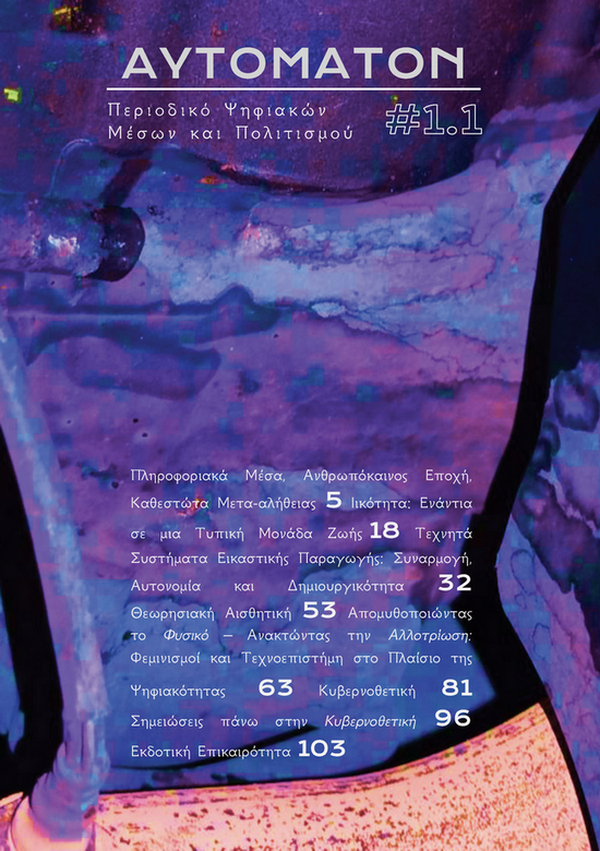Τεχνητά Συστήματα Εικαστικής Παραγωγής: Συναρμογή, Αυτονομία και Δημιουργικότητα

Περίληψη
Τις τελευταίες δεκαετίες, στο πεδίο της θεωρίας της τέχνης, γίνεται προσπάθεια
αφομοίωσης και χαρτογράφησης μιας αναδυόμενης τάσης καλλιτεχνικής παραγωγής, η οποία σχετίζεται με την ικανότητα τεχνητών συστημάτων και αλγορίθμων να δημιουργούν έργα τέχνης με μια σχετική αυτονομία. Στην προοπτική ύπαρξης εξ ολοκλήρου αυτόνομων συστημάτων καλλιτεχνικής δημιουργίας στο εγγύς μέλλον, η παρούσα εργασία επιχειρεί να θέσει υπό αμφισβήτηση την εξήγηση της τεχνητής δημιουργικότητας της παραγωγικής τέχνης (generative art) μέσω του ανθρωποκεντρικού παραδείγματος. Μέσω της παρατήρησης μεταμοντέρνων και σύγχρονων εικαστικών projects, η ανάλυση φανερώνει πως η φύση της αλληλεπίδρασης των καλλιτεχνών/προγραμματιστών με τα τεχνητά συστήματα εικαστικής παραγωγής, οδηγεί σε μια γόνιμη κατανόηση έμβιων και άβιων δημιουργικών δρώντων στο πλαίσιο μιας συναρμογής (assemblage), με στόχο την από κοινού εξερεύνηση νέων δυνατοτήτων καλλιτεχνικής δημιουργίας. Το δεύτερο μέρος, διερευνά κατά πόσο η ακαμψία που χαρακτηρίζει του αλγόριθμους μετριάζεται μέσω της ανάδειξης των λιγότερο γνωστών πτυχών της συμπεριφοράς τους και εάν οι πτυχές αυτές δύνανται να αποτελέσουν δίοδο προς την οντολογική εξερεύνηση της τεχνητής δημιουργικότητας. Υπό ένα μεθοδολογικό πρίσμα, η συζήτηση καταδεικνύει την ανάγκη συγκρότησης ενός θεωρητικού πλαισίου το οποίο θα απομακρύνει την εν λόγω τάση από την τεχνολογική μεθόριο στην οποία βρισκόταν καθηλωμένη για χρόνια και θα επιτρέψει την ένταξή της στην εξελικτική αλυσίδα του τεχνοϊστορικού αφηγήματος.
Λεπτομέρειες άρθρου
- Πώς να δημιουργήσετε Αναφορές
-
Σοφοκλέους Σ. (2023). Τεχνητά Συστήματα Εικαστικής Παραγωγής: Συναρμογή, Αυτονομία και Δημιουργικότητα. Αυτόματον: Περιοδικό Ψηφιακών Μέσων και Πολιτισμού, 1(1), 32–52. https://doi.org/10.12681/automaton.28575
- Τεύχος
- Τόμ. 1 Αρ. 1 (2021)
- Ενότητα
- Articles

Αυτή η εργασία είναι αδειοδοτημένη υπό το CC Αναφορά Δημιουργού 4.0.
Οι Συγγραφείς που δημοσιεύουν εργασίες τους σε αυτό το περιοδικό συμφωνούν στους παρακάτω όρους:
1. Οι Συγγραφείς διατηρούν τα Πνευματικά Δικαιώματα και χορηγούν στο περιοδικό το δικαίωμα της πρώτης δημοσίευσης ενώ ταυτόχρονα τα πνευματικά δικαιώματα της εργασίας προστατεύονται σύμφωνα με την Creative Commons Attribution License που επιτρέπει σε τρίτους - αποδέκτες της άδειας να χρησιμοποιούν την εργασία όπως θέλουν με την προϋπόθεση της διατήρησης των διατυπώσεων που προβλέπονται στην άδεια σχετικά με την αναφορά στον αρχικό δημιουργό και την αρχική δημοσίευση σε αυτό το περιοδικό.
2. Οι Συγγραφείς μπορούν να συνάπτουν ξεχωριστές, και πρόσθετες συμβάσεις και συμφωνίες για την μη αποκλειστική διανομή της εργασίας όπως δημοσιεύτηκε στο περιοδικό αυτό (π.χ. κατάθεση σε ένα ακαδημαϊκό καταθετήριο ή δημοσίευση σε ένα βιβλίο), με την προϋπόθεση της αναγνώρισης και την αναφοράς της πρώτης δημοσίευσης σε αυτό το περιοδικό.
3. Το περιοδικό επιτρέπει και ενθαρρύνει τους Συγγραφείς να καταθέτουν τις εργασίες τους μέσω διαδικτύου (π.χ. σε ένα ακαδημαϊκό καταθετήριο ή στους προσωπικές τους ιστοσελίδες) πριν και μετά από τις διαδικασίες της δημοσίευσης, καθώς αυτό μπορεί να οδηγήσει σε παραγωγική ανταλλαγή ιδεών και σκέψεων καθώς επίσης και σε γρηγορότερη και μεγαλύτερη χρήση και ευρετηρίαση της δημοσιευμένης εργασίας (See The Effect of Open Access).


